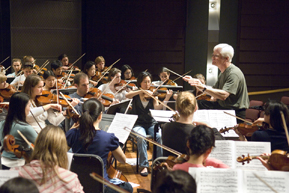Three Boundary-Pushing Classics at Tsai Center
BU Symphony Orchestra performs tonight

Tonight, the Boston University Symphony Orchestra will perform pieces from three different eras, each of which, says conductor David Hoose, “pushes the barriers.”
“All three of the compositions are, in different ways, outlandish,” says Hoose, a College of Fine Arts professor and the director of orchestral activities at the school of music. The orchestra will tackle Symphonie Fantastique by Hector Berlioz, Lacrimosa by Donald Sur, and Suite from The Miraculous Mandarin by Béla Bartók.
“I cannot imagine a concert of fresher, more vital and unconventional music,” Hoose says. “Sur, Bartók, and Berlioz — Korean, Hungarian, and French brothers in wild, fiery, whacky, often outlandish worlds, every moment infused with unstoppable passion.”
Berlioz composed Symphonie Fantastique in 1830 as a profession of love for an Irish actress he had seen on stage playing Ophelia in Hamlet. He produced the symphony and sent the actress, whom he had not met, an invitation. She ignored it, but two years later they met and were married. The autobiographical plot centers on a young musician who falls desperately and obsessively in love with a woman. Its imaginative sound was unique, but the story itself controversial. “Berlioz’s most famed piece is no less crazy today than it was when its premiere shocked and delighted its audience,” says Hoose. “This is because of an original and unusual use of the orchestra and because of the music’s utter emotional unpredictability.”
Sur composed Lacrimosa in 1991 after being commissioned by the Foundation of Broadcast Culture to write a piece for the Seoul Philharmonic to commemorate the 1919 Korean uprising, a series of demonstrations for Korean national independence from Japan. A composer who has been called eclectic by the New York Times, Sur is also known for The Unicorn and the Lady, a work inspired by the famous tapestries in The Cloisters, part of the Metropolitan Museum of Art, and Slavery Documents, his largest work, based upon antebellum and Biblical texts. “Sur’s music creates its own path,” Hoose says, “repeatedly letting us believe we know where it’s heading, only to surprise us with the fluidity and freshness of his musical mind.” Sur died in 1999.
The ballet from which Béla Bartók’s Suite from The Miraculous Mandarin is taken premiered in Cologne in 1926. It caused a scandal when first performed and was subsequently banned in Bartók’s native Hungary because the plot, about hooligans who force a young woman into prostitution, was considered lewd. A mysterious Mandarin man seeks the prostitute’s services, but instead the hooligans attempt to rob and murder him. To their confusion, they are unable to harm him. The prostitute, revolted by the violence, embraces the man, who then finally bleeds and dies. “It was the tawdry and vicious story, as well as some of the most forward-looking music — both erotic and violent — that led to the censoring of Béla Bartók’s ballet The Miraculous Mandarin before it even came to performance,” according to Hoose. “It, too, is a pulse-raising, harrowing, edge-of-your-seat ride whose ultimate destination cannot be seen.”
Bartók was especially influenced by Central European folk music and is known for inserting colorful effects in his compositions, such as the unorthodox combination of violins and xylophones.
The BU Symphony Orchestra will perform Symphonie Fantastique by Hector Berlioz, Lacrimosa by Donald Sur, and Suite from The Miraculous Mandarin by Béla Bartók on Tuesday, February 12, at 8 p.m. in the Tsai Performance Center, 685 Commonwealth Ave. The concert is free and open to the public.
Amy Laskowski can be reached at amlaskow@bu.edu.
Comments & Discussion
Boston University moderates comments to facilitate an informed, substantive, civil conversation. Abusive, profane, self-promotional, misleading, incoherent or off-topic comments will be rejected. Moderators are staffed during regular business hours (EST) and can only accept comments written in English. Statistics or facts must include a citation or a link to the citation.